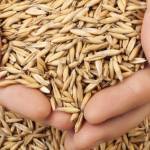Does Your Horse’s Diet Need an Overhaul?

Feeding practices employed by horse owners in the early 1900s frequently relied on traditions, intuition, and word-of-mouth suggestions. Have you embraced the scientific-based recommendations made by today’s equine nutritionists? Is a dietary overhaul in your horse’s future? Let’s find out!
Take a minute to think about the following statements. Would you agree or disagree with each one?
- I routinely feed my horse oats, barley, or corn with nothing else mixed in.
- I add fat to my horse’s diet.
- I weigh my horse’s feeds.
- I offer nutritional supplements to my horse.
Keeping your answers in mind, read on!
1. Many modern horses are fed the same basic grains that were offered at the turn of the century.
“One of the major differences between then and now is that research conducted later in the 1900s found improved digestibility of nutrients when these grains were processed in some way prior to feeding,” explained Kathleen Crandell, Ph.D, an equine nutritionist with Kentucky Equine Research (KER). Because of this grains, are routinely processed. For example, oats are rolled or crimped, and corn is cracked or steam-flaked.
Commercial feeds are now widely available, and are balanced in terms of vitamins, minerals, and other nutrients through the addition of a premix. Those feeds are designed to meet the physiological needs of horses of various ages, breeds, and uses based on research conducted in the latter part of last century and the beginning of the current one.
2. The addition of fat to equine diets didn’t become popular until the 1970s. Fats are now frequently used to help keep weight on hard keepers or used in lieu of additional concentrates as a source of energy in athletic horses.
While corn oil remains a popular choice among owners, an increasing body of evidence suggests that fats with a lower omega-6 to omega-3 ratio, like canola or soybean oil, are more beneficial to horses. If using significant amounts of oil for energy, then it is advisable to balance the ratio of omega-3s to omega-6s with something that is high in omega-3s.
“Marine-derived omega-3 fatty acids, like those supplied in EO•3, have a more desirable omega-3 to omega-6 ratio of 6:1 compared to corn oil,” shared Crandell.
3. Even back in the early 1900, horse owners were encouraged to weigh their horse’s feedstuffs. For example, one review article published near the turn of the last century* described feeding horses in pounds of hay and grain depending on work. Though nutritionists advise horse owners in much the same way today, many owners continue to feed by volume (two flakes of hay in the morning plus a scoop of concentrate and a smattering of supplements) rather than by weight and work level.
“It really is important to weigh a horse’s feeds, especially considering the steadily increasing number of overweight and obese horses in developed countries,” Crandell advised.
4. Horse owners in the first half of the 1900s seemed to understand the basic nutritional requirements of horses, especially given that many individual nutrients, like selenium, weren’t recognized as essential until after 1950. Even equine nutrition handbooks published in the 1920s failed to mention the necessity of a salt supplement for all horses. Perhaps as a knee-jerk reaction, owners now enthusiastically embrace nutritional supplements and at times oversupplement their horses, as recently described in dressage and eventing horses**.
To maximize the health and longevity of your horse, consult with an equine nutritionist, especially if your horse has an underlying medical condition such as insulin resistance, metabolic syndrome, heaves, laminitis, or osteoarthritis. A knowledgeable, professional nutritionist can help revamp your horse’s diet, tailoring it to their individual needs. Start a conversation with a KER nutrition advisor today.
*Harris, P.A. 1998. Developments in equine nutrition: Comparing the beginning and end of this century. Journal of Nutrition. 128:2698S-2703S.
**Agar, C., R. Gemmill, T. Hollands, et al. 2016. The use of nutritional supplements in dressage and eventing horses. Veterinary Record Open. 3:e000154.








